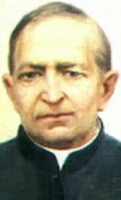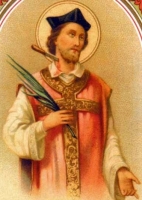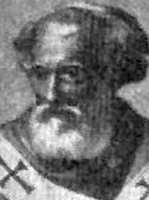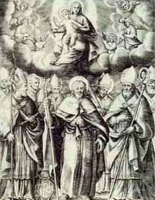| 29 January |
• yesterday • tomorrow |

Julian the Poor
• 31 August (city and diocese of Macerata, Italy)
• last Sunday in August (hunters in Malta)
Noble layman; friend and counselor to the king, he was married to a wealthy widow. A stag he was hunting predicted he would kill his own parents. Julian moved far away to avoid his parents, but they found him, and came to make a surprise visit. His wife gave them her and Julian's bed; Julian killed them, thinking they were his wife and another man.
As penance, he and his wife travelled to Rome, Italy as pilgrims seeking absolution. On his way home, to continue his penance, Julian built a hospice beside a river, cared for the poor and sick, and rowed travellers across the river for free.
Once, after having helped many, many travellers, Julian gave his own bed to a pilgrim leper who had nearly frozen to death. When they had him safely settled, the man suddenly revealed himself to be an angel. The visitor announced that Christ had accepted Julian's penance; the angel then disappeared.
Immensely popular in times past; scholars today think the story is likely to be pious fiction, mistaken for history.
• boatmen
• carnival workers
• childless people
• circus workers
• clowns
• ferrymen
• fiddlers
• fiddle players
• hospitality
• hotel-keepers, innkeepers
• jugglers
• knights
• Macerata, Italy
• penitent murderers
• pilgrims
• San Giljan, Malta
• shepherds
• to obtain lodging while travelling
• travellers
• wandering musicians
• carrying a leper through a river
• ferryman
• hart
• holding an oar
• man listening to a talking stag
• oar
• stag
• with Jesus and Saint Martha as patrons of travellers
• young hunter with a stag
• young man killing his parents in bed
• young man wearing a fur-lined cloak, sword, and gloves
• young, well-dressed man holding a hawk on his finger
https://catholicsaints.info/saint-julian-the-hospitaller/

• Cluain Dallain
• Dallan Forchella
• Dallan Forgaill
• Dallan of Cluain Dallain
• Eochaidh
Son of Colla Mac Erc and Forchella; related to Irish royalty, and to Saint Aidan of Ferns. Noted student who went blind as a young man; some said it was due to too much reading. Chief bard and poet of Ireland in 575; he reformed the Bardic Order, thus helping preserve the Gaelic language and literature. His most famous work is Ambra Choluim Kille (Eulogy of Saint Columba) after Columba had defended the institution of the bards; legend says that upon its recitation, his eyesight was restored. He is generally considered a martyr, having died in an attack on a monastery.
c.530 in Magh Slécht, County Cavan, Connaught, Ireland
• beheaded by pirates in 598 at the monastery at Inis-coel (Inniskeel), Ireland
• legend says that his head was thrown into the sea, washed back up on shore, and re-attached to his body so he could continue to recite poetry during the attack
• Be Thou My Vision
• Eulogy of Saint Columba
• Eulogy of Senan
Be Thou my vision, O Lord of my heart;
Naught be all else to me save that Thou art.
Thou my best thought by day or by night,
Waking or sleeping Thy presence my light.
Be Thou my wisdom, and Thou my true Word;
I ever with Thee and Thou with me, Lord;
Thou my great Father, I Thy true son;
Thou in me dwelling, and I with Thee one.
Be Thou my battle-shield, sword for my fight,
Be Thou my dignity, Thou my delight.
Thou my soul's shelter, Thou my high tower.
Raise Thou me heavenward, O Power of my power.
Riches I heed not, nor man's empty praise,
Thou mine inheritance, now and always;
Thou and Thou only, first in my heart,
High King of heaven my Treasure Thou art.
High King of heaven, my victory won,
May I reach heaven's joys, O bright heaven's son,
Heart of my heart, whatever befall
Still be my vision, O ruler of all.
- Saint Dallan
https://catholicsaints.info/saint-dallan-forghaill/

Sixth of the eleven children of John Markiewicz and Marianna Gryziecka; his father was the mayor of Pruchnik, Poland. Raised in a pious family, but at one point nearly lost his faith due to the anti-Church atmosphere of his school. Seminarian at Przemysl in 1863. Ordained in the diocese of Przemysl for Latins on 15 September 1867. Parish priest at Harta and the cathedral of Przemysl for six years. Studied at the University of Leopoli and University of Cracow. Parish priest at Gac in 1875. Parish priest at Blazowa in 1877. Taught pastoral theology at the seminary at Przemysl in 1882.
Joined the Salesians near Turin, Italy in November 1885, making his final vows on 25 March 1887. Spiritual student of Saint John Bosco. Contracted tuberculosis in 1889, and nearly died. Returned to Poland on 23 March 1892 where he served as parish priest at Miejsce Piastowe and began a concerted effort at youth ministry. Started a trade school for poor and orphaned boys, and soon had hundreds of children in his care. Founded the Society of Moderation and Work in 1898 to work with youth based on the spirituality of Saint John Bosco; the associated magazine Moderation and Work began publication on 16 July 1898. Opened an orphanage in Pawlikowice which soon had over 400 residents. The endless work finally broke his health, and at age 69 he lost his battle with consumption.
13 July 1842 at Pruchnik, archdiocese of Przemysl dei Latini, Poland
29 January 1912 at Miejsce Piastowe, Poland of complications related to tuberculosis
• 19 June 2005 by Pope Benedict XVI
• recognition celebrated by Cardinal Jozef Glemp in Pilsudski Square, Warsaw, Poland
https://catholicsaints.info/blessed-bronislaw-markiewicz/

Badonicus
Born to the English nobility. As a child, he was placed under the care of a nearby monastery where he was trained by Saint Illtyd. Friend of Saint Samson of York and Saint Peter Aurelian. Teacher of Saint Finnian of Clonard, Saint Kenneth of Wales, and Blessed Bieuzy of Brittany. Exceptional student. Monk. Moved to Ireland to study and give his life over to God. Priest. Evangelist in Britain. Founded churches and monasteries in Ireland. Abbot. Miracle worker. Following a pilgrimage to Rome, Italy he became a hermit, living on the tiny island of Rhuys. He attracted followers, and his hermitage became a monastery where he served as its abbot. Wrote several works aimed at monks, encouraging them to holiness. Spiritual advisor. After several years, he returned to England to preach in the north, at which vocation he spent the rest of his life. Earliest British historian; his works were used by Bede the Venerable.
c.516 at Scotland, possibly at Clydeside
c.570 at Houat, Brittany (in modern France)
with a bell nearby
https://catholicsaints.info/saint-gildas-the-wise/

Franciscan friar, received into the order by Francis himself. Established Franciscan missions in several locations. Arriving in Rome after a long journey, Juniper encountered people who had heard of his sanctity, and had come to see him. Alarmed at this reception, Juniper escaped to a nearby see-saw where he played with the children till the sight-seers decided that he was an idiot and left disgusted; he then continued to the convent. Once he cared for a sick man who craved a meal of pig's feet. Juniper captured a pig in a nearby field, cut off a foot, and cooked it for the sick man. When pig's owner found this, he angrily went to Juniper's superior. Juniper apologized so profusely, he talked the farmer into donating the pig.
• 1258 of natural causes
• buried at Ara Coeli Church at Rome, Italy
Would to God, my brothers, I had a whole forest of such Junipers. - Saint Francis of Assisi
A perfect friar would have "the patience of Brother Juniper, who attained the state of perfect patience because he kept the truth of his low estate constantly in mind, whose supreme desire was to follow Christ on the way of the cross." - Saint Francis of Assisi
https://catholicsaints.info/saint-juniper/
• Charles of Cologne
• Charles of Heisterbach
• Charles of Hemmerode
• Charles of Hocht
• Charles of Villers
• Carolus, Karl
Son of a wealthy merchant from Cologne, Germany. Trained as a soldier. Knight. On his way home from a jousting tournament, he finally gave into the call to religious life and became a Cistercian monk at Hemmerode in 1185. Prior of Heisterbach Abbey in 1189. Abbot of Villers Abbey in Brabant in 1197. He was gentle but very firm in sticking to the Rule of his house. Supervised construction at the abbeys. Believing he was soon to die, he resigned his positions in 1209, and returned to Hemmerode. He lived another three years in quiet prayer.
c.1150
1212 at Hemmerode of natural causes
https://catholicsaints.info/blessed-charles-of-sayn/

Priest. Offered the diocese in Cologne, Germany, but turned it down to become a wandering preacher, travelling to Paris, France and Milan, Italy, fighting Arianism. Missionary bishop, ordained in Milan. Murdered by Arians.
in Bavaria, Germany
• stabbed to death in 650 at Milan, Italy
• body thrown into the sewers, but recovered by a group of porters who took him to the nearby oratory of the basilica of San Lorenzo
• buried in the Chapel of the Queens in Milan
• the chapel was later re-named for him, and his relics enshrined in an urn
porters
man with a sword through his neck
https://catholicsaints.info/saint-aquilinus-of-milan/

Costanzo of Perugia
First bishop of Perugia, Italy at age 30. He evangelized his people, cared for the poor, and lived a simple life that shamed the ruling classes. Imprisoned, tortured and martyred with many of his flock in the persecution of Marcus Aurelius.
• beheaded in 170
• relics in an altar in the church of San Constanzo in 1205
• relics re-enshrined in 1781
• relics re-enshrined in 1825 at a new altar in the present church of San Constanzo
• Perugia-Città della Pieve, Italy, archdiocese of
• Perugia, Italy, city of
https://catholicsaints.info/saint-constantius-of-perugia/

Giovanni de Gaeta
Benedictine monk at Monte Cassino. Counsellor to Pope Pascal II. Cardinal. Chancellor of the Vatican. Chosen 161st Pope. His election was contested by Cenzio Frangipani who imprisoned him; a Roman mob rescued him and placed him on the throne. He struggled with Holy Roman Emperor Henry V and his appointed anti-pope, Maurice Bourdin, for control of the corporate church, and fled to France to escape their forces.
c.1058 at Gaeta, Italy as Giovanni de Gaeta
24 January 1118
29 January 1119 at Cluny, France of pleurisy
https://catholicsaints.info/pope-saint-gelasius-ii/
Premonstratensian nun in the monastery of San Pablo de Sordillos in Burgos, Spain; the sisters there soon had to move to San Miguel de Villamayor de Treviño, Spain. After a pilgrimage to Rome, Italy, and possibly to the Holy Lands, Radegonda felt a need to live as a recluse. She was closed up in a cell near the church of San Miguel, and lived the rest of her days as a prayerful anchoress.
Villamayor de Treviño, Burgos, Spain
• 29 January 1156 in San Miguel de Villamayor de Treviño, Spain of natural causes
• buried in the cloister of her monastery
• relics transferred to the church of San Miguel in 1612
https://catholicsaints.info/blessed-radegonda/

Bishop of Bourges, France in 584. Attended the Council of Macon in 585. Spiritual teacher of Saint Clair. Wrote a popular biography of Saint Martin of Tours, which work is credited for spreading the story of Martin, who was a model of holiness in medieval times.
29 January 591 of natural causes
https://catholicsaints.info/saint-sulpicius-severus/
• Gildas the Albanian
• Gildas the Scot
Son of Caunus, a chieftain in areas in northern Britain. Monk at Llancarvan. Spiritual student of Saint Cadoc. Hermit on the islands of Ronech and Ecni off the south coast of Wales. Wandering preacher and evangelist in the British Isles. In late life he retired to live as a prayerful monk at Glastonbury Abbey.
• 512 at Glastonbury Abbey of natural causes
• relics were at Glastonbury, but appear to have been lost over the centuries
https://catholicsaints.info/saint-gildas-the-elder/

• Agnes of Sarsina
• Agnese...
Camaldolese nun at the Santa Lucia convent near Bagno di Romagna, Italy. Friend of Blessed Joan of Bagno di Romagna.
Sarsina, Forlì, Italy
12th century Bagno di Romagna, Forlì, Italy of natural causes
15 April 1823 by Pope Pius VII (cultus confirmation)
https://catholicsaints.info/blessed-agnes-of-bagno-di-romagna/

Nun. Founded the Congregation of the Missionary Sisters of the Holy Family to promote Christian unity, help the poor and teacher girls about Christian life.
3 July 1862 in Lowicz, Lódzkie, Poland
29 January 1946 in Bialystok, Podlaskie, Poland of natural causes
5 June 1991 by Pope John Paul II
https://catholicsaints.info/blessed-boleslawa-maria-lament/

• Abbondanza di Spoleto
• Abondance
• Abondanoe the Martyr
• Bonde the Martyr
Widow of Spoleto, Italy. Gave Christian burial to martyrs in the area, including Saint Gregory of Spoleto. Martyred in the persecutions of Diocletian.
c.304
https://catholicsaints.info/saint-abundantia-the-martyr/

Potamio, Potamius
Priest. Bishop of Agrigento, Italy in the mid-6th-century. Began teaching Saint Gregory of Agrigento in 567, and ordained him into the priesthood in 571.
early 6th century
late 6th century Italy of natural causes
https://catholicsaints.info/saint-potamione-of-agrigento/
Valerio
Bishop of Ravenna, Italy from 788 until his death in 810, serving for 22 years. Known as a zealous pastor to his people, he helped decorate churches and fought endlessly against the heresy of Arianism.
• 15 March 810 of natural causes
• relics enshrined in the cathedral of Ravenna, Italy on 9 May 1222
https://catholicsaints.info/saint-valerius-of-ravenna/
• Aphraates of Edessa
• Afraates of...
Studied pagan magic as a young man, but converted to Christianity in Jerusalem. He then retired to Edessa, Mesopotamia as an anchorite living in a small house outside the city walls. Preached and wrote against the Arian heresy.
Persia
c.378 near Antioch, Syria (in modern Turkey)
https://catholicsaints.info/saint-aphraates/
Nephew of imperial proconsol Ablavio. One of a group of 80 Christians who had all been converted and baptized in Todi, Italy by Saint Cassiano, and who were all marytred together in the persecutions of Diocletian, condemned by Ablavio.
• 303 in Todi, Italy
• buried in Confino near Lake Trasimeno in Italy
https://catholicsaints.info/saint-seustio/
Sister of Saint Sarbelius. Convert, brought to the faith by Saint Barsimeus of Edessa. Tortured and executed in the persecutions of Emperor Trajan. Martyr.
Syria
burned with hot irons, scourged and then speared to death in 101 at Edessa, Mesopotamia
https://catholicsaints.info/saint-barbea-of-edessa/
Sharbel
Brother of Saint Barbea. Pagan high priest at Edessa, Mesopotamia. Convert to Christianity. Tortured with red-hot irons, and martyred in the persecutions of Emperor Trajan.
101 at Edessa, Mesopotamia
https://catholicsaints.info/saint-sarbelius/
Flora
Lay-sister and cook in the Kildare, Ireland convent of Saint Brigid. Known for her simple, personsal sanctity, and for her loyalty to Saint Brigid.
523 of natural causes
https://catholicsaints.info/saint-blath-of-kildare/
Bishop of Trier in modern Germany. Legend makes him a disciple of Saint Peter the Apostle, but it's doubtful such a disciple would have lived into the 4th century.
c.320
https://catholicsaints.info/saint-valerius-of-trier/
Deacon in Angoulême, France under Saint Ausonius.
1st century of natural causes
https://catholicsaints.info/saint-caesarius-of-angouleme/
Walloch
Bishop. Missionary to Scotland.
Ireland
c.724 of natural causes
https://catholicsaints.info/saint-voloc/
Serano
Bishop.
interred in the cathedral of Oviedo, Italy since the 11th century
https://catholicsaints.info/saint-serrano/
Imperial Roman soldier. Martyred for defending the faith.
303 in Rome, Italy
https://catholicsaints.info/saint-maurus-of-rome/
Imperial Roman soldier. Martyred for defending the faith.
303 in Rome, Italy
https://catholicsaints.info/saint-papias-of-rome/
CatholicSaints.Info Portable Edition